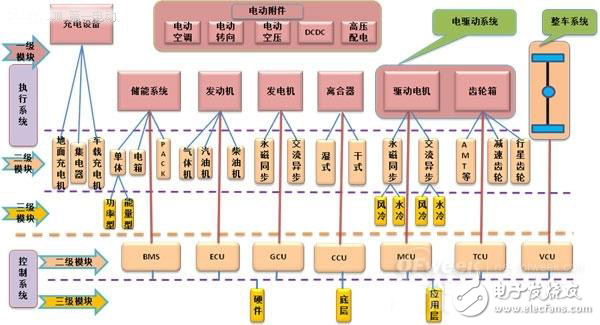In 2014, the domestic production and sales of new energy vehicles surpassed 80,000 units, marking a promising development trend. To help new energy enthusiasts and junior R&D professionals better understand the core technologies behind these vehicles, the author combined insights from the R&D process to explore the classification of new energy vehicles, module planning, electronic control technology, and charging infrastructure.
**1 New Energy Vehicle Classification**
When it comes to classifying new energy vehicles, terms like "weak hybrid," "strong hybrid," "series," and "parallel" can be confusing for those outside the industry. In reality, these classifications are based on different perspectives and are not contradictory. Understanding them from both a consumer and technical standpoint helps clarify their meanings.
**1.1 Consumer Perspective**
From the consumer's viewpoint, vehicles are typically categorized based on the degree of hybridization. This includes start-stop systems, weak hybrids, medium hybrids, strong hybrids, plug-in hybrids, and pure electric vehicles. Each category reflects varying levels of fuel efficiency and cost implications. As shown in Table 1, the more "+" signs indicate better performance, while the "-" sign indicates the absence or weakness of a feature. It’s clear that as fuel efficiency improves, so does the cost.

**1.2 Technical Perspective**
From a technical standpoint, the complexity increases from pure electric to full hybrid systems. The configuration types include P0 (BSG system), P1 (ISG system), P2 (motor between clutch and transmission), P3 (motor at transmission output or rear axle), and P03 (combination of P0 and P3). These configurations vary by region; for instance, P2 is common in Europe, while planetary gear systems dominate in Japan and the U.S., such as in P03 setups. These structures are widely used in four-wheel drive vehicles, with models like the Outlander and Peugeot 3008 already in mass production. When choosing a new energy vehicle, factors like structural complexity, fuel economy, and cost must all be considered.
**2 New Energy Vehicle Module Planning**
Although the classification of new energy vehicles is complex, many modules are shared across different types. Using modular design during development allows for platform sharing and faster development cycles. Typically, a new energy vehicle is divided into a three-level module system, as illustrated in Figure 2. The first level includes the execution system, such as charging equipment, electric accessories, energy storage systems, and drive components. The second level consists of execution and control systems, covering various parts like chargers, energy storage units, engines, generators, clutches, and motors. The third level involves power and energy types, including cooling methods and software layers of the control system.

Figure 2: Three-Level Module System
Based on functional similarities, some modules can form platform architectures for pure electric, plug-in hybrid, and extended-range vehicles. These platforms are highly versatile, enabling resource sharing, improving system reliability, shortening development cycles, and reducing R&D and procurement costs.
**3 Core Technologies of New Energy Vehicles**
Within the three-level module system and platform architecture, three key technologies stand out: the Vehicle Control Unit (VCU), Motor Control Unit (MCU), and Battery Management System (BMS). These technologies significantly impact the vehicle’s performance, efficiency, and safety.
**3.1 VCU – Vehicle Control Unit**
The VCU is the central electronic control unit responsible for making driving decisions. Unlike traditional fuel vehicles, new energy vehicles require this component. By collecting signals such as accelerator pedal position, gear selection, and brake input, the VCU determines the driver’s intent. It also monitors vehicle status, such as speed and temperature, and sends control commands to the power and battery systems. Additionally, the VCU manages the operation mode of the accessory power system and has fault diagnosis, protection, and data storage capabilities.
Fc To Lc Adapter,Fiber Cable To Ethernet Converter,Fiber Optic Adapter Kit,Fiber To Ethernet Converter
Ningbo Fengwei Communication Technology Co., Ltd , https://www.fengweicommunication.com